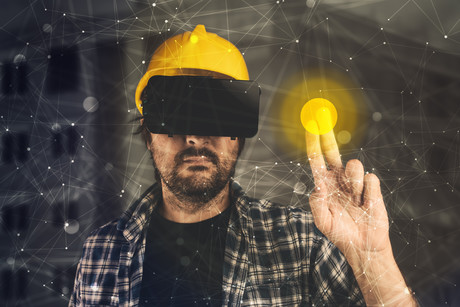
The benefits provided by immersive ‘world-within-a-world’ technologies like virtual and augmented reality is leading to increased uptake for safety and training applications across a range of industry sectors.
Virtual and augmented reality seem like relatively new developments, but both have a long history. Today’s simulated environment technology builds off ideas that date back to the 1800s and has been applied across a range of fields — to varying degrees of success — since the late 1960s. The ability to create a virtual world and have people ‘exist’ within it leads to heavy utilisation in gaming applications, but now the benefits are more broadly recognised and new uses are being developed.
What’s the difference?
There is a simple distinction between the two technologies:
- Virtual reality (VR) is a completely computer-generated environment which it is intended to simulate a real-life situation or location. Users are immersed in a virtual world, usually via a headset that provides visual and auditory stimuli relative to the setting.
- Augmented reality (AR) technology takes an existing environment and adds digitally produced information. This provides an enhanced overlay, commonly viewed on a mobile device.
Giving the game away
In high-risk industries — such as mining, engineering and construction — the use of simulated conditions allows workers to experience ‘real-world’ scenarios without the inherent risk, so it’s not surprising these sectors are spearheading the use of VR and AR.
A notable example, Melbourne Water’s (MW) use of VR for hazard identification was recognised as the ‘best solution to a specific workplace Health & Safety issue’ at the 2017 Victorian Worksafe Awards.
The utility developed technology that identifies design defects and WHS risks in capital projects at the planning stage. Previously relying on two-dimensional drawings and 3D modelling, MW’s VR solution lessens the need for imagination and appraisals based on a limited understanding of the project scope.
MW found that some of the less obvious design and safety problems were overlooked using traditional techniques. This led to expensive and complex design fixes once construction was complete and the asset operational. It also put workers unnecessarily at risk of injury, as hazards were only recognised post-completion.
Immersion within a virtual version of the proposed asset is made possible by employing VR headsets. This set-up allows engineers to move freely about and interact with the planned environment from the safety of an office.
To verify the concept, MW ran trials of the technology in tandem with standard methods. The VR solution assisted in identification of 26 potential safety issues, versus just six uncovered using drawings and modelling. This success led to the utility adopting the technology as an integral part of the asset design process.
Perhaps buoyed by these achievements, Western Australia’s Water Corporation (WC) commenced trials of 3D VR simulations in November last year. Initially confined to water and wastewater infrastructure design, WC sees potential in the use of VR for other purposes including training and testing maintenance programs.
Digging deep
VR is commonly utilised for training in the mining industry and as a method to accompany class-based learnings in universities that offer infrastructure and engineering courses.
The University of Wollongong has collaborated with safety training provider Coal Services to develop an immersive VR system for training miners and rescue services workers. Recognising the limitations of hazard identification conducted from the safety of a classroom, the VR program was developed to facilitate a more authentic learning experience.
The resulting environment permits eight students at a time to experience a mining setting that includes common hazards, explosion simulations and guidance on conducting safety inspections. UOW believes it’s as close as anyone can get to being in a mine without ever entering a shaft and better prepares students for the real world.
The School of Mining Engineering at UNSW features a similar facility — the VR Suite — which simulates a range of mining scenarios and provides a high-impact learning experience that allows students to test and challenge concepts and theories in a safe environment.
A broader view
One of the limitations of VR is the relatively high cost — those headsets aren’t cheap, nor is developing a virtual world. Additionally, one of the chief benefits is also an application limitation — great for training and remote hazard identification, but no practical use for workers already on-site. This is an area where AR will most likely take over.
There are already apps that provide site-specific hazard information via a phone’s camera view, highlighting potential dangers relative to a worker’s exact location. It does require the site manager or OH&S team to identify and manually add each hazard but has the benefit of providing that information site-wide to every worker.
We’re likely to see further development of safety AR in the wearables space, building on the (thus far) limited success of safety glasses and hard hats which can provide environmental data and hazard identification, along with practical information such as work instructions.
Although it is still relatively early days for VR and AR industry applications, continual advances will drive improvements and continue to bring costs down, ensuring that these technologies will play a significant role in improving safety across many industry sectors.
Supporting the wellbeing of Australia's firefighters
Academics Dr DAVID LAWRENCE and WAVNE RIKKERS detail their continuing research in the area of...
Software-based COVID-19 controls help protect onsite workers
The solution decreases COVID-19-related risks by ensuring that contractors and visitors are...
Spatial distancing rules: are they insufficient for health workers?
Researchers have revealed that the recommended 1- to 2-metre spatial distancing rule may not be...









